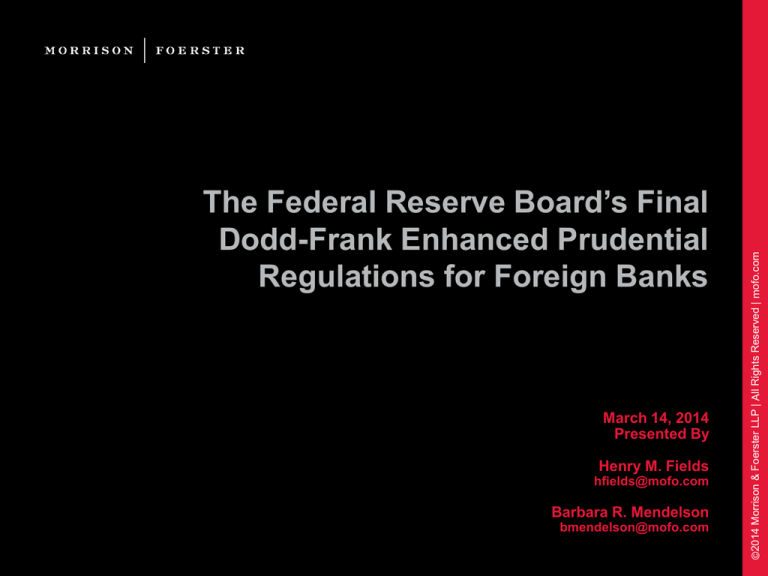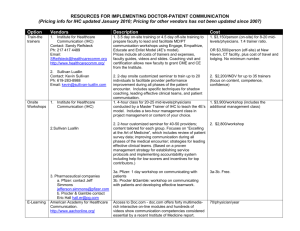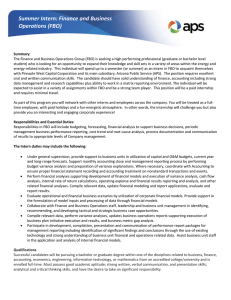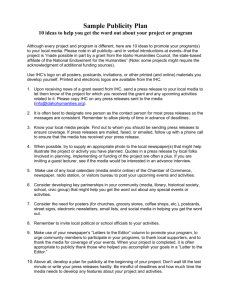
March 14, 2014
Presented By
Henry M. Fields
hfields@mofo.com
Barbara R. Mendelson
bmendelson@mofo.com
©2014 Morrison & Foerster LLP | All Rights Reserved | mofo.com
The Federal Reserve Board’s Final
Dodd-Frank Enhanced Prudential
Regulations for Foreign Banks
Today’s Discussion Topics
•
•
•
•
•
•
•
•
•
•
Background
Changes from the Proposals and Effective Dates
Coverage
Intermediate Holding Companies
Capital
Liquidity
Risk Management
Stress Testing
Debt-to-Equity Limits
Issues and Response Strategies
This is MoFo.
2
Other Topics
• Deferred Rulemaking
• Single-Counterparty Credit Limits
• Early Remediation Standards
• Enhanced Prudential Standards for Non-Bank Financial
Companies
• To be addressed on a case-by-case basis
This is MoFo.
3
Some Helpful Definitions
• Board – Federal Reserve Board
• FBO – Foreign banking organization as defined in the Board’s
Regulation K.
• IHC – U.S. intermediate holding company
• BHCA –U.S. Bank Holding Company Act
• BHC – Bank holding company as defined under the BHCA
• DFA – Dodd-Frank Wall Street Reform and Consumer Protection Act
• DPC subsidiaries – Subsidiaries of a U.S. branch/agency formed to
hold assets acquired in the ordinary course for debt previously
contracted (“DPC”)
This is MoFo.
4
Quantitative Thresholds
• Covered FBO – a FBO with $50BB+ of consolidated worldwide assets
• $10BB FBO – FBO with consolidated worldwide assets of between
$10BB and $50BB
• Combined U.S. Assets – the sum of the consolidated assets of each toptier U.S. subsidiary of the FBO (excluding any BHCA section 2(h)(2)
company) and the total assets of each U.S. branch and agency of the
FBO
• U.S. Non-branch Assets - the sum of the consolidated assets of the toptier U.S. subsidiaries of the FBO (excluding any BHCA section 2(h)(2)
company and DPC branch subsidiary)
• Combined U.S. Operations – the U.S. branches and agencies of an FBO
and (i) if the FBO has an IHC, the IHC and its subsidiaries; or (ii) if the
FBO does not have an IHC, the direct and indirect U.S. subsidiaries of
the FBO (excluding any section 2(h)(2) company, if applicable)
This is MoFo.
5
Background
• Proposed in December 2012 under DFA Sections
165,166 and 167
• Section 165: Enhanced supervision and prudential standards for
systemically important banks and nonbank financial companies
• Section 166: Early remediation requirements for systemically
important banks and nonbank financial companies
• Section 167: Intermediate holding company requirement for
systemically important nonbank financial companies
• FBO provisions modeled on DFA Section 165/166 rules
proposed in December 2011 for domestic bank holding
companies
This is MoFo.
6
Background
• Represents the Board’s attempt to create a workable
framework for the U.S. regulation of systemically
important FBOs under the DFA
• Board required to take into account national treatment
and competitive equality considerations
• Also reflects other discrete Board concerns
• Increased scope/complexity of FBOs’ U.S. nonbank operations
• Availability of home country financial resources for U.S.
operations of foreign banks and financial companies
• Availability of information on U.S. operations of foreign firms
• Use of U.S. branch/agency operations to fund home country or
offshore activities
This is MoFo.
7
Changes from Proposals/Effective Dates
• Final Rule defers action on single-counterparty credit
limits and early remediation standards
• Foreign nonbank financial institutions not covered and to
be evaluated by Board on a case-by-case basis
• Decreases liquidity buffer for U.S. branches and agencies
of FBO from 30 days to 14 days
• Extends initial compliance date for Covered FBOs from
July 1, 2015 to July 1, 2016
This is MoFo.
8
Changes from Proposals/Effective Dates
• Other changes applicable to IHCs
• Raises the threshold for requiring a Covered FBO to form an IHC
• Defers application of the leverage capital requirements and stress
test requirements to IHCs until January 1, 2018 and October 1,
2017, respectively
• Transition period to form an IHC extended (discussed below)
• Requires IHC implementation plan to be submitted by January 1,
2015
This is MoFo.
9
Coverage
• General Coverage
• All Covered FBOs
• $10BB FBOs are subject to stress testing and, if
publicly traded, risk committee requirements
• Tiered applicability based on size and footprint of U.S.
operations
This is MoFo.
10
Summary of Tiered Applicability
Size
Requirements
Subpart of Final Rule
$10BB FBOs
Company-run stress tests
Subpart L
$10BB FBOs that are publicly
traded
Risk committee
Subpart M
Covered FBO with less than
$50BB of Combined U.S. Assets
Risk-based and leverage capital
Risk committee
Liquidity
Capital stress testing
Subpart N
Debt-to-equity limits (upon grave threat determination)
Subpart U
Covered FBO with $50BB+ of
Combined U.S. Assets
This is MoFo.
Risk-based and leverage capital
Risk management framework
Risk committee and U.S. chief risk officer
Liquidity risk-management, stress-testing and buffers
Capital stress testing
Subpart O
U.S. IHC requirement (if U.S. Non-branch Assets of $50BB+)
Subpart O
Subpart E (IHC Supervisory Stress Test)
Subpart F (IHC Company-Run Stress Test)
Debt-to-equity limits (upon grave threat determination)
Subpart U
11
IHCs
• IHC not required under DFA section 165 but established
as an additional prudential standard
• Board may establish any appropriate additional prudential standard for
covered companies
• Purpose is to prevent or mitigate risks to U.S. financial stability
• IHC requirement intended to increase the resiliency of the U.S.
operations of large FBOs
• Also provides for a single focus for risk management of operations of
U.S. Non-branch Assets
• Provides “single point of entry” for resolution of operations of U.S. Nonbranch Assets
This is MoFo.
12
IHCs
• A Covered FBO with $50BB+ of U.S. Non-branch Assets
must consolidate those assets under an IHC
• The IHC requirement applies even if the Covered FBO does not
operate a bank or thrift in the U.S. – subjects such operations to
capital and other BHC-type requirements even though not a BHC
• U.S. Non-branch Assets are measured for this purpose based on
four prior quarters’ Form FR Y7-Q financial data
• Must provide notice to the Board within 30 days of establishing or
designating an IHC
This is MoFo.
13
IHCs
• IHC Compliance dates
• FBOs that meet the threshold on July 1, 2015 must form an IHC and
transfer their U.S. BHC and bank subsidiaries and substantially all of
their other U.S. nonbank subsidiary business to the IHC by July 1, 2016.
Full compliance must be achieved by July 1, 2017
• FBOs that meet the threshold after July 1, 2015 must comply by the first
day of the ninth quarter following the date on which it meets the threshold
• FBOs meeting the threshold as of June 30, 2014 must submit an
implementation plan by January 1, 2015
• Timeline for transfer of subsidiaries to IHC
• List of subsidiaries to be held or excluded from IHC
• Planned capital actions that will allow IHC capital compliance
• 3 years of pro forma quarterly financials
• How IHC will comply with risk management and liquidity stress
testing requirements
This is MoFo.
14
IHCs
• Structure and Regulation of the IHC
• IHCs must be organized under U.S. law
• All U.S. banking and nonbanking operations must be held under
the IHC, except
• U.S. branches and agencies of the FBO
• BHCA section 2(h)(2) companies owned by the FBO
• DPC branch subsidiaries
• Controlled merchant banking portfolio companies and/or
insurance companies must be held under the IHC – even though
not integral to U.S. operations
• IHCs must have a full-functioning board of directors or managers
• Use of BHCA “control” definition could create uncertainties for
companies owned at 10 – 24.99% level
This is MoFo.
15
IHCs
• Structure and Regulation of the IHC (contd.)
• IHCs subject to supervision and regulation comparable to U.S.
BHCs, including enhanced prudential standards
• Enhanced prudential standards apply to the consolidated operations
of the IHC, including foreign subsidiaries of the IHC
• Until the IHC becomes subject to the new parallel requirements
applicable to IHCs (date varies based on the type of requirement),
U.S. BHCs with $50BB+ of consolidated assets controlled by an FBO
are subject to enhanced prudential standards applicable to U.S.
BHCs beginning on January 1, 2015
This is MoFo.
16
IHCs
• Alternative Organizational Structures
• Home country law may prohibit FBO from owning U.S. subsidiaries
through a single U.S. IHC
• Other circumstances may warrant exceptions based on the FBO’s
activities, scope of operations, structure or similar considerations, e.g.
• an FBO controls multiple lower-tier FBOs that have separate U.S.
operations
• an FBO cannot transfer its ownership interest in a U.S. subsidiary to
an IHC or otherwise restructure its investment (passivity
commitment or supervisory agreement may be required)
• Alternative structures require application to Board
• “Virtual” U.S. IHC not permitted
• Board voices concerns about centralized risk management
• Exercise of resolution authority through holding company model
This is MoFo.
17
Capital
• Requirements for Covered FBOs:
• Beginning July 1, 2016, a Covered FBO must certify and
demonstrate compliance with capital adequacy standards at the
consolidated level consistent with the Basel Committee capital
framework
• Specific reports on applicable Basel capital ratios (including leverage
ratio) to be included in FR Y-7Q
• Must provide reports relating to their compliance with the Basel
capital adequacy standards (Board will propose these rules
separately as an amendment to the FR Y-7Q)
• FBO public disclosures must be consistent with the Basel Capital
Framework
• Failure to meet capital adequacy standards may result in Board
restrictions on U.S. activities or business operations
This is MoFo.
18
Capital
• IHCs
• IHCs are subject to U.S. risk-based capital and leverage requirements to
the same extent as U.S. BHCs (even if they are not BHCs)
• Must comply with leverage capital requirements by January 1, 2018
• Includes base 4% leverage ratio and, for IHCs with total consolidated assets
of $250BB+ or foreign exposures of $10BB+, 3% supplementary leverage
ratio
• Not required to implement advanced internal models based approach to
determine capital (even if a BHC)
• Until the IHC becomes subject to the new parallel requirements applicable to
U.S. BHCs, each subsidiary BHC and bank subsidiary of an FBO currently
subject to leverage capital requirements must continue to comply
• IHCs must comply with Board capital plan rule to the same extent as a
covered U.S. BHC (first plan would be due in January 2017)
• Must comply with risk-based capital and capital plan requirements by
July 1, 2016
This is MoFo.
19
Liquidity: Covered FBOs with less than $50BB
of Combined U.S. Assets
• Annual Basel Committee-consistent internal liquidity
stress test with results reported to the Board
• Failure to comply with this requirement obliges the
Covered FBO to limit the net aggregate amount owed by
the FBO parent office and non-U.S. affiliates to its
Combined U.S. Operations to 25% or less of the
Combined U.S. Operations’ third-party liabilities on a daily
basis
This is MoFo.
20
Liquidity: Covered FBOs with $50BB+ of
Combined U.S. Assets
• U.S. risk committee (see “Risk Management” below)
must:
• Approve the liquidity risk tolerance for the Combined U.S.
Operations at least annually
• Review information provided by senior management of the
Combined U.S. Operations at least semi-annually to determine
compliance with liquidity risk tolerance
• Approve the contingency funding plan for Combined U.S.
Operations at least annually or upon revision
• Conduct a liquidity risk review of significant business lines and
products of the Combined U.S. Operations at least annually
This is MoFo.
21
Liquidity: Covered FBOs with $50BB+ of
Combined U.S. Assets
• U.S. chief risk officer (see “Risk Management” below) must:
• Review liquidity risk management strategies, policies and procedures for
Combined U.S. Operations
• Review information provided by senior management of U.S. operations
to determine compliance with liquidity risk tolerance
• Report to the U.S. and enterprise-wide risk committee on U.S.
operations’ liquidity risk profile at least semi-annually (and establish
procedures governing the content of such reports)
• Approve new products and business lines based on liquidity risk
• At least quarterly:
• Review cash flow projections for Combined U.S. Operations
• Establish and determine compliance with liquidity risk limits
• And upon material revision, approve liquidity stress testing practices,
methodologies and assumptions
• Review liquidity stress testing results
• Approve liquidity buffer
This is MoFo.
22
Liquidity: Covered FBOs with $50BB+ of
Combined U.S. Assets
• Establish and maintain a liquidity risk management review function
independent of the management responsible for funding
• Regular (no less than annual) review of adequacy and effectiveness of
liquidity risk management processes within Combined U.S. Operations
and compliance with law
• Report liquidity risk management issues to U.S. risk committee and
enterprise-wide risk committee
• Produce comprehensive cash flow projections
• Establish and maintain a contingency funding plan
• Monitor sources of liquidity risk and establish liquidity risk limits
consistent with liquidity risk tolerance
• Establish and maintain procedures for collateral, legal entity, and
intraday liquidity risk monitoring
This is MoFo.
23
Liquidity: Covered FBOs with $50BB+ of
Combined U.S. Assets
• Conduct monthly (or more frequently as the Board may
require) liquidity stress tests that are reported to the
Board
• Separate testing of branch/agency network and IHC
• Stress testing must also be conducted for the Combined U.S.
Operations
• Policies, procedures and controls for liquidity stress testing are
required
• FBO parent of IHC is required to make available to the
Board in a timely manner the results of home-country
liquidity stress testing and the establishment of any
liquidity buffers
This is MoFo.
24
Liquidity: Covered FBOs with $50BB+ of
Combined U.S. Assets
• IHC must maintain in U.S. liquidity buffer of
unencumbered “highly liquid assets” equal to external
and internal “net stressed cash flow need” over a 30-day
horizon
• Liquidity buffer for IHC comprised of cash may not be held in an
account at a U.S. branch/agency or other affiliate that is not
controlled by the IHC
• U.S. branch/agency network must maintain in U.S. 14day liquidity buffer (change from proposal)
• Liquidity buffer for U.S. branch/agency network comprised of cash
may not be held in an account at the IHC or other affiliate
This is MoFo.
25
Risk Management
• $10BB FBOs that are publicly traded and Covered FBOs
with less than $50BB of Combined U.S. Assets
• The FBO must certify annually to the Board that it maintains a risk
committee that oversees the risk management policies (formerly
“practices”) of its Combined U.S. Operations, with at least one
member with risk management experience (formerly “expertise”)
• The risk committee may be a committee of the FBO’s global
board of directors or supervisory board
• The certification requirement would first apply on the later of July
1, 2016 or the first day of the ninth quarter following the date on
which it meets the threshold
• Certification to be filed concurrently with FR Y-7
• Noncompliance with risk management requirements may result in
Board-imposed limits on activities or business operations
This is MoFo.
26
Risk Management
• Covered FBOs with $50BB+ of Combined U.S. Assets
• FBO must also maintain a risk committee with at least one
member with risk management experience, and at least one
“independent” member
• An FBO conducting operations through U.S. branches/agencies may
place its risk committee at the FBO’s global board of directors or
supervisory board, or at the IHC if applicable
• An FBO that operates in the U.S. solely through an IHC must place
its U.S. risk committee at the IHC
• Risk committee must meet at least quarterly and fully document
and maintain records, including risk-management decisions
• Risk committee’s responsibilities include the liquidity riskmanagement responsibilities
This is MoFo.
27
Risk Management
• Covered FBOs with $50BB+ of Combined U.S. Assets
(cont.)
• U.S. risk committee would have a number of specific
responsibilities, including the obligation to:
• Approve and periodically review risk management policies of
Combined U.S. Operations or IHC
• Oversee the risk-management framework that is commensurate with
the structure, risk profile, complexity, and size of Combined U.S.
Operations or IHC
• An FBO generally may rely on its parent company’s enterprisewide risk management policies for its U.S. operations
• IHC must have its own risk committee to oversee the risk function
of the IHC (but may also fulfill the responsibilities of the U.S. risk
committee of the Combined U.S. Operations)
This is MoFo.
28
Risk Management
• Covered FBOs with $50BB+ of Combined U.S. Assets
(cont.)
• The FBO or its IHC must appoint a U.S. chief risk officer, who
must:
• Have risk management experience (formerly “expertise”)
• Be independently compensated
• Be employed by and located in the U.S. branch/agency, IHC, or
another U.S. subsidiary
• Report directly and regularly provide information to the U.S. risk
committee and global risk officer
• Undertake liquidity risk-management responsibilities
This is MoFo.
29
Risk Management
• Covered FBOs with $50BB+ of Combined U.S. Assets
(cont.)
• The U.S. chief risk officer must oversee:
• Measurement, aggregation, and monitoring of risks of U.S. combined
operations
• Implementation of and compliance with the policies and procedures
for reporting risks and risk-management deficiencies
• Management, monitoring and testing of risks and risk controls
• Noncompliance with risk management requirements may
result in Board-imposed limits on activities or business
operations
This is MoFo.
30
Stress Testing
• $10BB FBOs and Covered FBOs with less than $50BB of
Combined U.S. Assets
• Must be subject to a consolidated home country stress-testing
regime that includes either (i) an annual supervisory stress test,
or (ii) or a supervisor-reviewed annual internal stress test
• The home country regime also must include requirements for
governance and controls of the stress testing regime
• The FBO must conduct and pass the home country stress test
• These requirements also apply to foreign savings and loan
holding companies of $10BB+ in assets (DFA requirement)
• Separate information/reporting requirements of the sort applicable
to Covered FBOs with $50BB+ of Combined U.S. Assets
(discussed below) would not apply
This is MoFo.
31
Stress Testing
• $10BB FBOs and Covered FBOs with less than $50BB of
Combined U.S. Assets (cont.)
• Failure to comply with these requirements would trigger:
• An asset maintenance requirement for the FBO’s U.S.
branch/agency network of “eligible assets” equal to 105% of
third-party liabilities
• An annual stress test requirement of its U.S. subsidiaries. This
test could be conducted separately or as part of an enterprisewide stress test
This is MoFo.
32
Stress Testing
• Covered FBOs with $50BB+ of Combined U.S. Assets
• FBOs having a U.S. branch/agency must be subject to a
consolidated home country stress-testing regime that includes
either (i) an annual supervisory stress test, or (ii) or a supervisorreviewed annual internal stress test
• Home country regime also must include requirements for
governance and controls of the stress testing regime
• FBO must conduct and pass the home country stress test
• FBO must report summary information about its stress-testing
activities and results by January 5 of each year
This is MoFo.
33
Stress Testing
• Covered FBOs with $50BB+ of Combined U.S. Assets
(cont.)
• U.S. branch/agency networks in a net “due from” position to their
foreign parent/affiliates have additional reporting requirements,
determined on a case-by-case basis and accounting for the size,
complexity, and business activities of the FBO and its U.S.
operations
• Additional information required by January 5 of each year
• Confidentiality of information would be determined in accordance
with existing Board and FOIA requirements
This is MoFo.
34
Stress Testing
• Covered FBOs with $50BB+ of Combined U.S. Assets
(cont.)
• Consequences of failure to comply:
• An asset maintenance requirement
• U.S. branch/agency network would have to hold “eligible assets”
equal to 108% of third party liabilities
• Annual stress test requirement for U.S. subsidiaries (to the
extent that an FBO has not established an IHC)
• The Board would have the authority to impose liquidity buffers
or intragroup funding restrictions on noncompliant FBOs
This is MoFo.
35
Stress Testing
• IHCs
• IHCs are subject to the annual supervisory and semi-annual
company-run stress testing requirements applicable to similarlysized U.S. BHCs
• Must comply by October 1, 2017
• Requirements for U.S. subsidiaries of IHCs:
• Until the IHC becomes subject to the new parallel requirements
applicable to IHCs, each subsidiary BHC and insured depository
institution of an FBO currently subject to stress test requirements
must continue to comply through September 30, 2017
This is MoFo.
36
Debt-to-Equity Limits
• Covered FBOs:
• A conditional debt-to-equity limit of not more than 15-to-1, upon a
determination by the U.S. Financial Stability Oversight Council
that a Covered FBO poses a “grave threat” to U.S. financial
stability, and that the debt-to-equity limit is necessary to mitigate
that risk
• The limits would be applied to any IHC and any U.S. subsidiary
(other than a section 2(h)(2) company or DPC branch subsidiary)
that is not part of an IHC structure
• In addition, the FBO’s U.S. branch/agency network would be
subject to a daily 108% asset maintenance requirement
This is MoFo.
37
Issues and Response Strategies
• The economic and regulatory costs of the Final Rule could be
substantial in some cases, and will need to be carefully assessed by
affected FBOs (which will essentially include any FBOs with U.S.
banking operations)
• That being said, the impact of the Final Rule on FBOs will be widely
disparate, depending on the nature and footprint of an FBO’s U.S.
operations
• Possible Strategic Responses
• Reduce size of U.S. operations, especially capital-intensive
operations
• Move certain U.S. operations into the U.S. branch/agency network
• Board discusses this possibility and will be monitoring
This is MoFo.
38
Issues and Response Strategies
• Possible FBO response strategies:
• Review nature and scope of U.S. operations and their role in, and
consistency with, the enterprise’s strategic planning efforts and
outcomes
• Quantify economic and regulatory costs of the compliance with
standards for various thresholds (i.e. total consolidated assets,
Combined U.S. Assets, and U.S. Non-branch Assets)
• Assess impact of the Final Rule on enterprise profitability
• Critically consider adjustments to U.S. operations based on the
foregoing reviews
• If applicable, consider potential alternative organizational structures
in lieu of establishing a single IHC
This is MoFo.
39
Deferred Topics
• Single-counterparty Credit Limits
• The Board is continuing to develop single-counterparty credit limits required under
DFA Section 165 based on the results of a quantitative impact study conducted
last summer and the Basel Committee’s initiative to develop a regulatory
framework governing large credit exposures that would apply to all global banks
• Early Remediation Requirements (DFA Section 166)
• The Board is continuing to review comments on early remediation requirements
and is integrating the remediation levels with the Basel III capital rules adopted in
July 2013
• Prudential Requirements for Systemically Important
Nonbank Financial Companies (DFA Section 167)
• Unlike the proposal’s one-size-fits-all approach for nonbank financial companies,
the Final Rule provides that the Board will apply enhanced prudential standards
on a case-by-case basis
This is MoFo.
40
About Morrison & Foerster
We are Morrison & Foerster—a global firm of exceptional credentials.
Our clients include some of the largest financial institutions,
investment banks, Fortune 100, technology and life sciences
companies. We’ve been included on The American Lawyer’s A-List
for 10 straight years, and Fortune named us one of the “100 Best
Companies to Work For.” Our lawyers are committed to achieving
innovative and business-minded results for our clients, while
preserving the differences that make us stronger. This is MoFo. Visit
us at www.mofo.com.
© 2014 Morrison & Foerster LLP. All rights reserved.
This is MoFo.
41




